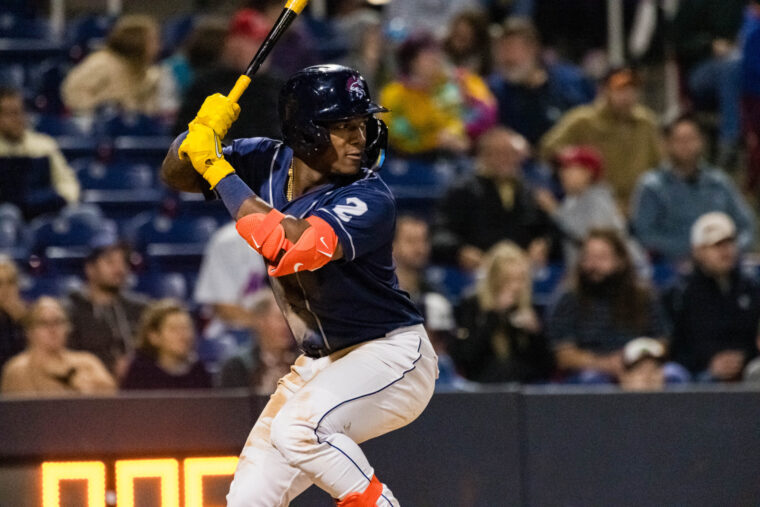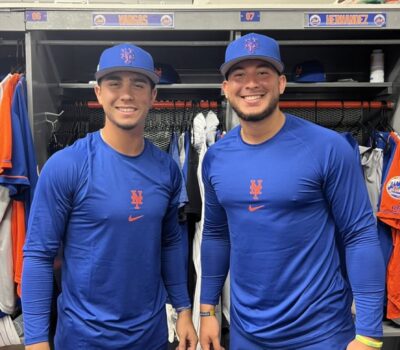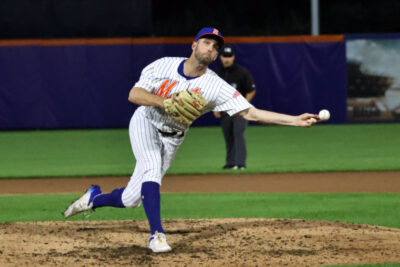
Photo by Bronson Harris of the Binghamton Rumble Ponies
The Mets entered the 2023 season with lofty aspirations after winning 101 games and making the playoffs in 2022. They spent a record amount of money in free agency to retain core members of the team as well as add impressive talent to the roster.
Unfortunately, the 2023 season didn’t go according to plan and, after starting the season 14-7, the Mets found themselves below .500 with the trade deadline approaching. That prompted Steve Cohen and former GM Billy Eppler to become sellers.
What followed was an historic trade deadline where the Mets completed trades with various teams and shipped off big-name players such as Justin Verlander, Max Scherzer, and David Robertson, among others. Naturally, the Mets boosted their farm system by acquiring high-level prospects in these deals. Let’s take a look at how these prospects performed within the Mets’ organization in 2023.

Marco Vargas and Ronald Hernandez, Photo from FCL Mets
Marco Vargas and Ronald Hernandez
The trade that kicked off the Mets’ selling spree was a deal that sent David Robertson to the Miami Marlins. The Mets received teenagers Marco Vargas and Ronald Hernandez, a return that initially seemed light for a closer that recorded a 2.05 ERA in 44 innings up to that point. However, many were impressed with Eppler’s ability to pry especially Vargas away from Miami.
Vargas, a middle infielder, had an .899 OPS at the time of the trade in the Florida Complex League, where he was younger than most of the competition he played against. Vargas struggled after the trade and in 15 games with the FCL Mets, he recorded just three extra-base hits, five RBIs, and a .666 OPS.
He spent most of his time at second base, where he recorded no errors, but he also spent time at shortstop and third base where he had a little bit more trouble fielding the ball. Vargas, still just 18, is currently ranked as MMO’s no. 7 prospect.
Hernandez, a catcher, was certainly the lesser of the two prospects acquired in this deal but he actually excelled following his trade to the Mets, unlike Vargas. At the time of the trade, Hernandez had recorded a .916 OPS in the Florida Complex League, and he managed to improve that in 14 games with the FCL Mets where he posted a .995 OPS.
In that stretch he managed to walk 15 times and strike out just 10 times, and also get on base more than half the time (.509 OBP). Hernandez, now 20, is currently ranked as MMO’s no. 18 prospect.
Luisangel Acuña
Two days after unloading Robertson to the Marlins, the Mets and Rangers completed a blockbuster trade that sent Max Scherzer and cash to Texas for top-prospect Luisangel Acuña. Acuña, the younger brother of likely National League MVP Ronald Acuña Jr., arrived to the Mets and immediately became MMO’s no. 1 prospect in the organization. While Acuña doesn’t have the ceiling his brother has reached, he has his own skillset that made him a coveted player by the Mets’ front office.
Acuña started the year with Double-A Frisco where he recorded an impressive slash line of .315/.377/.453/.830 with 42 stolen bases in 84 games. After the trade Acuña reported to Double-A Binghamton where he flashed his potential but ultimately disappointed. In 37 games with Binghamton,
Acuña recorded just a .622 OPS and struck out twice as often as he walked. He did record 15 stolen bases, bringing his total to 57 over the entirety of the season, but he didn’t do much beyond that. Defensively, he played mostly shortstop but also spent some time at second base.
Justin Jarvis
The day after the Mets acquired Acuña they completed another trade, this time with the Milwaukee Brewers. This trade was not as high-profile, as it saw Mark Canha go to Milwaukee in exchange for pitching prospect Justin Jarvis. Jarvis arrived to the Mets having spent most of his time in Double-A, but had made three starts for Milwaukee’s Triple-A affiliate. He currently ranks as MMO’s no. 16 prospect.
Jarvis experienced great success with Double-A Biloxi where he recorded a 3.69 ERA in 14 starts. He was not as successful in Triple-A Nashville where he recorded a 12.34 ERA in three starts. Jarvis’ struggles continued after his trade with the Mets, where he joined Triple-A Syracuse.
In nine starts with the team, he recorded an ERA of 8.04 with his WHIP hovering over 2.00. While starting pitcher win-loss records aren’t as indicative of success or failure, he did go 0-5 with Syracuse to finish the year 0-7 overall in Triple-A. The Mets are hoping the 23-year-old can turn it around this upcoming season, where he could potentially see the majors if the team needs to reach into its pitching depth.

Drew Gilbert, Photo by Anne-Marie Caruso of NorthJersey/USA TODAY NETWORK
Drew Gilbert and Ryan Clifford
Arguably the Mets’ most exciting trade in terms of the return was another blockbuster deal that saw Justin Verlander shipped to his former team, the Houston Astros, along with cash in exchange for two of their top prospects in Drew Gilbert and Ryan Clifford. At the time of the trade, Gilbert was ranked as Houston’s no. 1 overall prospect and Clifford was ranked as Houston’s no. 4 overall prospect according to MLB Pipeline, a massive get for a 40-year-old pitcher, albeit a future Hall of Famer in Verlander.
Gilbert started the year in High-A where he recorded a 1.107 ERA before moving up to Double-A Corpus Christi. The 23-year-old struggled a bit as he recorded just a .713 OPS in 60 games. After his trade to the Mets, though, Gilbert demonstrated the ability that made him a first round pick in 2022.
During the team’s run to the Eastern League Championship Series, Gilbert recorded a slash line of .325/.423/.561/.984 with six home runs and 21 RBIs in 35 games. He played mostly center field but also saw time in both corner outfield spots, and all signs are pointing to him being a major name in the Mets’ organization for years to come. He currently ranks as MMO’s no. 2 prospect, behind only Acuña.
Unlike Gilbert, Clifford actually arrived to the Mets swinging a hot bat but cooled down once he became a member of High-A Brooklyn. In the Astros’ organization, Clifford started the year in Low-A where he succeeded before being promoted to High-A and also swang the bat well, recording a .903 OPS before the trade. After he was traded to the Mets, though, he struggled in Brooklyn where he hit .188/.307/.376/.683 with six home runs and 20 RBIs in 32 games.
He did demonstrate flashes here and there of the power ability that made him so coveted by the Mets. He is also still just 20 years old, so the Mets are hoping that he will continue to improve as he matures. In the field, Clifford manned both corner outfield spots but primarily played first base. He currently ranks as MMO’s no. 5 prospect.
Jeremiah Jackson
One of the more surprising trades the Mets made at the trade deadline in terms of return on investment was a deal that saw Dominic Leone go to the Angels for Jeremiah Jackson. At the time of the deal, Leone was undoubtedly a piece the Mets were willing to move, as he had just a 4.40 ERA out of the bullpen. Jackson seemed to be a huge get for a player of Leone’s caliber, as he came to the Mets with 15 home runs and a .768 OPS in Double-A.
Jackson actually improved upon those statistics once he joined Double-A Binghamton, as he hit seven home runs in 129 at-bats and recorded an .802 OPS. He also improved his batting average from .248 with Double-A Rocket City to .264 with Binghamton.
Jackson also managed to provide defensive versatility by playing all over the diamond. In addition to second base and shortstop, his primary positions, Jackson also spent time at third base and in both corner outfield spots. The 23-year-old currently ranks as MMO’s no. 29 prospect.
Jeremy Rodriguez
Tommy Pham was one of the most notable bats on the market at the trade deadline, and the Mets sent him to the Arizona Diamondbacks for Jeremy Rodriguez. If your first thought was, “who?” then you’re not alone.
Rodriguez had just turned 17 the month prior and was not a Top 30 prospect in the Diamondbacks’ system according to MLB Pipeline. He also does not currently rank among MMO’s Top 30 prospects. Still, though, he lit it up with the Mets in the Dominican Summer League in a showing that warrants excitement.
Prior to the trade, Rodriguez had recorded a .740 OPS in 38 games with Arizona’s Dominican Summer League team. With the Mets, however, he shined in just 13 games. Across 56 plate appearances, Rodriguez hit .422/.536/.711/1.247 with 11 walks and four strikeouts.
He also recorded eight extra-base hits, including three triples, and seven stolen bases while being caught just once. He played mostly shortstop but also played two games at second base. Rodriguez is certainly a long-term investment, as he’s a long way’s away from any type of major league consideration, but the Mets are surely hoping that it will be worth it in the end.

Adam Kolarek, Photo by Herm Card
Phil Bickford and Adam Kolarek
The final trade the Mets made prior to the trade deadline was a deal where the Mets simply needed pitching, and they sent cash to the Dodgers for relievers Phil Bickford and Adam Kolarek. Bickford had struggled with Los Angeles prior to the deal, as he recorded a 5.14 ERA in 42 innings for their major league team.
He spent all of his time with the Mets on the major league team, where he also struggled. Across 25 1/3 innings, he recorded a 4.62 ERA.
Kolarek was the more interesting acquisition, simply because he began his career in the Mets organization all the way back in 2010. He spent the first part of the 2023 season in Triple-A with the Dodgers, where he recorded a 2.40 ERA.
After being traded to the Mets, he began in Triple-A Syracuse where he threw just 5 1/3 innings and allowed two earned runs. He eventually made it to the big league club, where he threw 4 2/3 scoreless innings before being designated for assignment. He then wound up signing a minor league deal with the Braves, where he is still a member of the organization.

